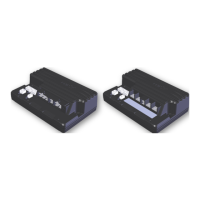Warning
1. Route the cables and fasten all scooter components in a position so that the cables, the connectors and
the connector sockets of the RHINO2 do not allow water entry or suffer from physical strain, abuse or
damage, such as cutting or crushing. Take particular care on scooters with movable structures such as
seat raise. Make sure that the cables do not extend beyond the scooter so that they cannot be caught or
damaged by external objects. Adequate strain relief must be provided and the mechanical limits of the
cables/looms must not be exceeded. Ensure connectors are fully mated.
2. Cables should be adequately routed and secured to prevent pinching, cutting, crushing and chafing from
both the mechanics of the scooter and external objects.
3. Cables with live pins should be restrained.
4. Disconnect all the cables of the scooter at the powered end whenever units are replaced or moved.
5. It is the responsibility of the installer to make sure that the finished wiring package is safe and fit for
purpose.
6. Before making any connections to the controller, disable the scooter by one of the following means to
prevent accidental movement.
1. Place the battery circuit breaker in the open position.
2. Disconnect the motor or batteries and/or elevate the drive wheels.
7. To meet ISO requirements, the Battery and Motor connectors must be fixed in such a way they cannot
be swapped or transposed. Alternatively, these may be protected by a cover that cannot be removed
without the use of tools.
8. If the DS160 or DS180 is not mounted under the scooter cover, then the cover accessory must be used.
9. The scooter user maintenance schedule and service instructions should include appropriate inspection
and maintenance requirements for connectors, cables and wiring. It should also warn against the
dangers of poor installation and maintenance of cables.
10. The cable size, insulation and connectors should be selected to ensure that any temperature rise during
a fault condition does not result in visible damage or temperatures in excess of the dry air rated
temperature.
11. Only use the defined contacts, connectors and boots with the wiring looms.
12. Provide support for cables, which are subject to frequent bending, with a cable chain or equivalent
mechanism. Thoroughly test the cabling system where frequent cable-flexing is part of the intended
application, and especially, consider the loom operation at low temperatures.
Note
To meet the requirements of relevant standards, a status indicator must be fitted to the scooter.
GBK51948 RHINO2
Installation Manual Issue 5
Installation and testing - Page 21

